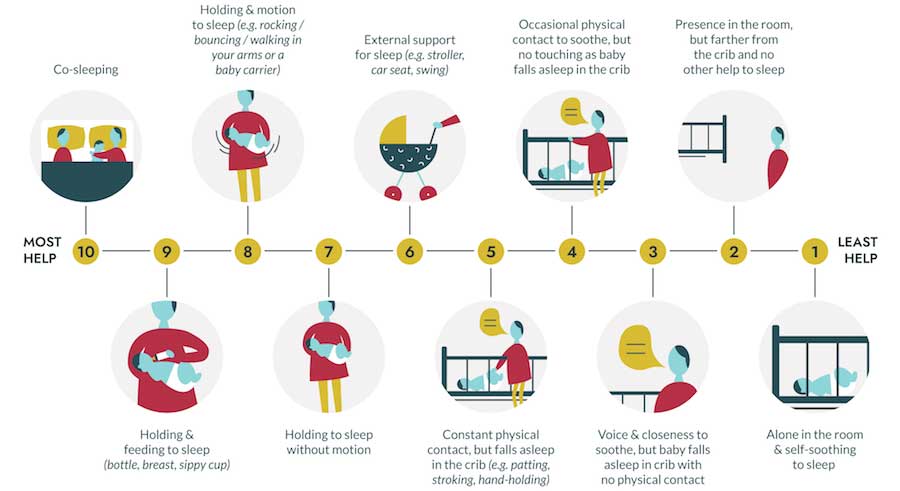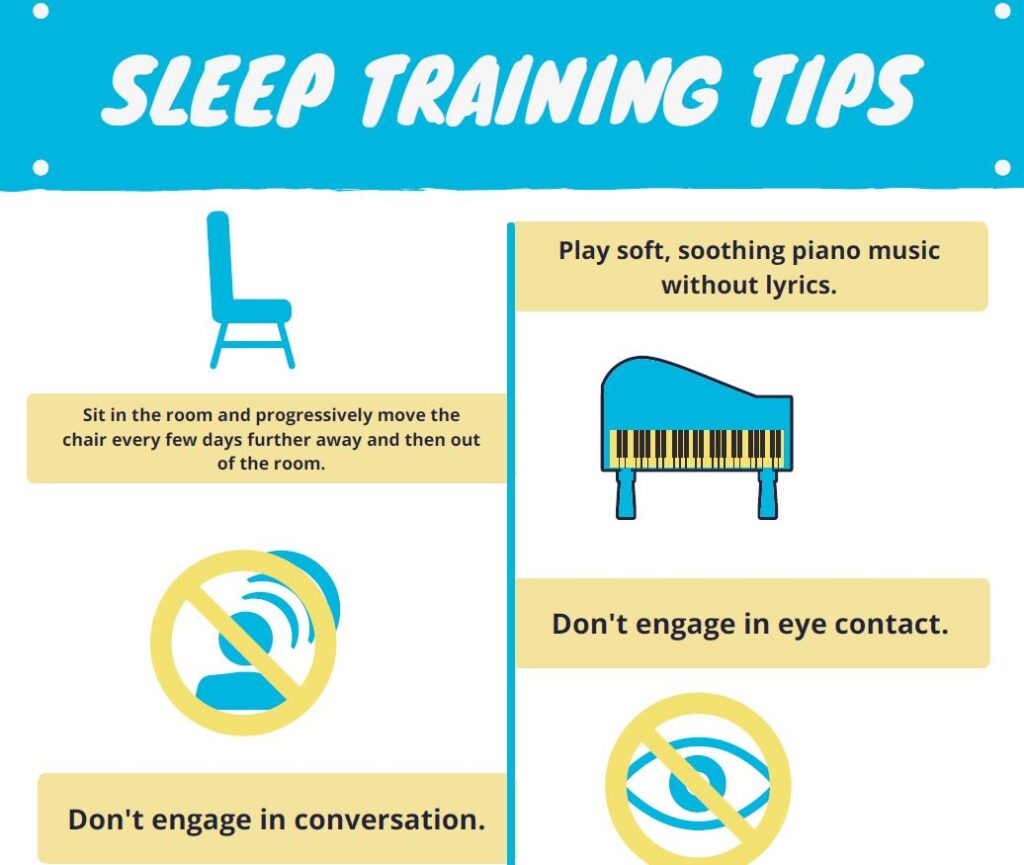Find out how to manage sleep training and breastfeeding together for a well-rested baby and mom. Helpful tips and successful sleep strategies.

Sleep deprivation and breastfeeding. Two words that can send shivers down the spine of any new parent. You crave a good night’s sleep, but your little one seems to thrive on the 2 am feeding schedule. This is where sleep training steps in, but can it coexist peacefully with breastfeeding?
You hear about sleep training, but worry it might interfere with breastfeeding. Fear not, weary parents! This article is here to navigate the often-confusing waters of breastfeeding and sleep training, offering a gentle and informative guide to help you and your baby get the rest you deserve.
The Sleep Struggle is Real
Let’s be honest, those 4 am nursing sessions, while beautiful in their way, can leave you feeling like a zombie mom. Sleep deprivation can affect mood, patience, and energy levels, impacting bonding and daily functioning. Additionally, babies thrive on predictable sleep patterns, crucial for physical and cognitive development. So, finding solutions to fragmented sleep becomes a priority for many families.

But Don’t Panic!
Before diving into sleep training, remember that frequent night wakings are normal for young babies. Their tiny tummies can’t hold much milk at once, so frequent feeding is essential. Additionally, night wakings can signal other needs like teething, discomfort, or simply seeking comfort and connection.
Understanding Baby Sleep
Newborns have tiny tummies and immature digestive systems, requiring frequent feeding, often every 2-3 hours around the clock. This is normal and crucial for their growth and development. As they mature, their sleep patterns gradually shift towards longer stretches, typically around 4-6 months of age.
Before diving into techniques, let’s understand sleep development in babies. Each baby is unique, and their sleep patterns will evolve with age and developmental stages. Here’s a general overview:
- Newborns (0-3 months): Expect frequent wakings (every 2-3 hours) for feeding and comfort.
- 4-6 months: Sleep patterns start to regulate, with longer stretches at night (5-6 hours).
- 6-12 months: Most babies can sleep through the night, but wakings for comfort or teething are still common.
- Beyond 12 months: Sleep continues to consolidate, with fewer night wakings.
Why Do Babies Wake So Often at Night?
It’s not because they’re trying to torture you (although you might feel that way in the moment!). Here’s the science behind their nighttime habits:
- Tiny Tummies, Frequent Needs: Newborns have small stomachs, meaning they can’t store much milk at once. Frequent feedings ensure they get the calories and nutrients they need for rapid growth and development.
- Immature Sleep Cycles: Unlike adults, babies have shorter sleep cycles (around 45 minutes versus 90 minutes). They transition frequently between light and deep sleep, and often wake fully after each cycle, needing comfort and reassurance.
- Developmental needs: Night wakings can be a sign of growth spurts, teething, or other developmental milestones.
- Soothing and Security: Breastfeeding isn’t just about food; it’s about comfort, connection, and security. Your presence and the warmth of your skin signal safety and love, essential for emotional well-being.

Why Night Wakings Matter for Breastfeeding
- Milk Production: Frequent nighttime breastfeeding stimulates prolactin, the hormone responsible for milk production. This ensures your milk supply meets your baby’s growing needs. Skipping night feeds can lead to a decrease in milk production, potentially impacting your breastfeeding journey.
- Emptying the Breasts: Regular emptying of your breasts helps prevent engorgement and mastitis, painful conditions that can hinder breastfeeding and impact your baby’s latch.
- Comfort and Bonding: Nighttime feeds are more than just nourishment. They provide comfort, warmth, and security for your baby, strengthening the bond between you and them.
Sleep Training: What it actually is?
Sleep training for babies is the process of teaching them to fall asleep and stay asleep independently. This usually involves putting them down drowsy but awake in their crib and allowing them to self-soothe without intervention from you.
Additionally, sleep training teaches babies how to return to sleep when they wake up during the night, as nighttime waking is a natural aspect of the sleep cycle, even for adults.
What sleep training isn’t
Initially, sleep training and night weaning aren’t always linked. You can still give your baby a feeding once or twice at night, depending on their age and developmental stage. Consult your pediatrician to determine when it’s suitable to completely eliminate nighttime feedings for your baby.
This is just one example of how sleep training isn’t as severe as it may seem. It doesn’t necessarily entail closing the nursery door and allowing your baby to cry all night. Instead, you can adjust the amount of crying your baby experiences to a level that you’re comfortable with before offering a calming song or a gentle back rub.

Breastfeeding and Sleep Training
Now, the million-dollar question: can you sleep train while breastfeeding? The answer is it depends. Traditional sleep training methods that involve letting babies cry it out might not be the best fit for breastfed babies, especially young ones. Here’s why:
- Milk supply: Frequent nursing at night helps maintain milk supply. Reducing night feeds too abruptly can lead to a decrease in production.
- Early weaning: Separation anxiety during sleep training can lead some babies to self-wean prematurely.
- Emotional needs: Breastfeeding offers comfort and security, and removing that source abruptly can be stressful for babies.
How Does Sleep Training Affect Milk Supply?
Sleep training methods that involve letting your baby cry for extended periods can negatively impact milk supply. When your baby cries, their stress hormones rise, which can suppress milk production. Additionally, skipping nighttime feedings can lead to a decrease in milk production as your body adjusts to the reduced demand.
Also Read: Does Stress Affect Milk Supply? Know The Impact and Remedies – What Every Mom Should Know
Does Breastfeeding Affect Sleep Training?
It can, in certain ways. Breastfeeding offers comfort, security, and nourishment, making it a natural sleep aid for babies. However, relying solely on nursing to sleep can make transitioning to independent sleep more challenging.
The Effects of Sleep Training on Moms and Babies
The impact of sleep training on breastfeeding relationships varies and depends on several factors like your baby’s age, temperament, and the specific method used. However, some potential effects include:
For moms:
- Stress and anxiety: Hearing your baby cry can be stressful and emotionally draining.
- Negative impact on milk production: As mentioned earlier, sleep training can lead to a decrease in milk supply.
- Guilt and frustration: Feeling like you need to choose between sleep and breastfeeding can be emotionally challenging.
For babies:
- Stress and insecurity: Crying for extended periods can be stressful for babies and impact their emotional well-being.
- Confusion and difficulty self-soothing: Babies may not understand why they’re being left alone to cry, making it harder for them to learn to self-soothe.
- Negative impact on breastfeeding relationship: Sleep training can disrupt the natural rhythm of breastfeeding and impact the bond between mother and baby.

Finding Balance: How Can New Moms and Babies Get More Sleep?
Remember, your journey is unique. While frequent night wakings are normal, there are some tips to help both mom and baby get more sleep without compromising your breastfeeding goals:
- Develop a consistent bedtime routine: This signals to your baby that it’s time to wind down and prepare for sleep.
- Create a calming sleep environment: Ensure a dark, quiet, and comfortable space for sleep.
- Practice good sleep hygiene: Create a relaxing bedtime routine for yourself and your baby. This could include a warm bath, a massage, and calming music.
- Offer comfort without feeding: If your baby wakes but doesn’t seem hungry, offer soothing techniques like rocking, patting, or singing.
- Co-sleep safely: If you feel comfortable, co-sleeping can make nighttime feedings easier and more manageable. However, always ensure safe co-sleeping practices.
- Learn to nurse lying down: This can help you get some rest while feeding your baby at night.
- Delegate tasks: Share household chores and childcare responsibilities with your partner or other caregivers.
- Seek support: Talk to a lactation consultant or sleep coach who can offer personalized guidance and support.
Sleep Training and Breastfeeding Schedule
Instead of focusing on traditional sleep training methods, consider approaches that are more compatible with breastfeeding:
- 7:00 PM: Bath, calming activities, bedtime feed
- 7:30 PM: Put baby down drowsy but awake
- 10:00 PM – 2:00 AM: Respond to hunger cues with feeding and soothing
- 2:00 AM – 6:00 AM: Aim for longer sleep stretches, using responsive feeding
- 6:00 AM: Wake for the day, offer a morning feed

Gentle Sleep Training Tips
- Establish a consistent bedtime routine: This helps signal to your baby that it’s time to wind down. Include a warm bath, calming music, and a gentle feeding session.
- Offer comfort without feeding: During night wakings, soothe your baby with rocking, shushing, or patting. Avoid rushing to feed unless they seem truly hungry.
- Respond gradually: If your baby cries, respond calmly and promptly. Offer comfort without feeding immediately. Over time, they’ll learn to self-soothe with your support.
- Be patient and consistent: Remember, sleep training takes time and patience. Don’t get discouraged if you have setbacks. Consistency is key to success.
Breastfeeding Considerations:
- Nighttime feedings are important: Even with sleep training, your baby may still need to feed at night, especially under 6 months.
- Offer the breast first: If your baby wakes at night, offer the breast first before resorting to other methods. This ensures they get the calories and comfort they need.
- Pump if needed: If you’re concerned about milk supply, pump after long stretches of sleep or when your baby isn’t nursing as frequently.
- Communicate with your partner: Share responsibilities and communicate your needs. Tag-teaming nighttime wakings can help prevent burnout.
Additional Considerations:
- Age matters: Sleep training methods may be more suitable for older babies (around 6-8 months) who have established longer sleep stretches and are developmentally ready for more independence.
- Feeding method: While this article focuses on breastfeeding, similar considerations apply to formula-fed babies. Consult your pediatrician for tailored advice.
- Sleep environment: Ensure a safe and comfortable sleep environment with a firm mattress, fitted sheet, and no loose objects.
Beyond Sleep Training
Remember, sleep training isn’t a magic solution. It’s a process that takes time, patience, and consistency. Focus on creating a loving and supportive environment where your baby feels safe and secure, and trust that their sleep patterns will naturally evolve with time.
Conclusion:
Breastfeeding and sleep training can co-exist, but it requires a gentle and informed approach. By understanding your baby’s needs, prioritizing their well-being, and exploring alternative methods, you can navigate this journey with confidence and ensure both you and your little one get the rest you deserve.
Please note: This article is for informational purposes only and should not be substituted for professional medical advice. Always consult with your pediatrician or a qualified healthcare professional for personalized guidance regarding your baby’s sleep and feeding needs.
—————–
Resource:
Top Image: mynewborn.com.au

Hi, I’m Lindley! I’m a stay-at-home-mom sharing all of the tips and tricks I learn throughout my motherhood journey. I’m now navigating through wife life and being a mom while blogging my crazy adventures. I’m so glad to have you along for the ride!



